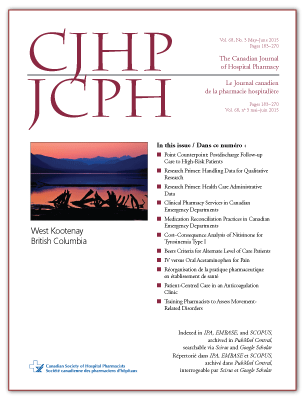Application of the Beers Criteria to Alternate Level of Care Patients in Hospital Inpatient Units
DOI:
https://doi.org/10.4212/cjhp.v68i3.1455Keywords:
beers criteria, alternate level of care, retrospective, adverse events, Canada, critères de Beers, autre niveau de soins, analyse rétrospective, événements indésirablesAbstract
ABSTRACT
Background: The Beers criteria were developed to help in identifying potentially inappropriate medications (PIMs) for elderly patients. These medications are often associated with adverse events and limited effectiveness in older adults. Patients awaiting an alternate level of care (ALC patients) are those who no longer require acute care hospital services and are waiting for placement elsewhere. They are often elderly, have complex medication regimens, and are at high risk of adverse events. At the time of this study no studies had applied the Beers criteria to ALC patients in Canadian hospitals.
Objectives: To determine the proportion of ALC patients receiving PIMs and the proportion experiencing selected PIM-related adverse events. Methods: A retrospective chart review of ALC patients 65 years of age or older was performed to identify PIMs and the occurrence of selected adverse events (specifically central nervous system [CNS] events, falls, bradycardia, hypoglycemia, seizures, insomnia, gastrointestinal bleeding, and urinary tract infections). A logistic regression model with a random intercept for each patient was constructed to estimate odds ratios and probabilities of adverse events.
Results: Fifty-two ALC patients were included in the study. Of these, 48 (92%) were taking a PIM. Of the 922 adverse events evaluated, 407 (44.1%) were associated with a regularly scheduled PIM. Among patients who were taking regularly scheduled PIMs, there was a significantly increased probability of an adverse CNS event and of a fall (p < 0.001 for both). The most common PIM medication classes were first-generation antihistamines (24 [46%] of the 52 patients), antipsychotics (21 patients [40%]), short-acting benzodiazepines (15 patients [29%]), and nonbenzodiazepine hypnotics (14 patients [27%]).
Conclusions: A high proportion of ALC patients were taking PIMs and experienced an adverse event that may have been related to these drugs. These findings suggest that the ALC population might benefit from regular medication review and monitoring to prevent or detect adverse events.
RÉSUMÉ
Contexte : Les critères de Beers ont été élaborés afin d’aider à détecter l’utilisation de médicaments potentiellement inappropriés (MPI) auprès des patients âgés. L’on associe souvent les MPI à des événements indésirables, et leur efficacité chez les personnes âgées est limitée. Les patients en attente d’un autre niveau de soins (patients ANS) sont ceux qui ne nécessitent plus de soins de courte durée de l’hôpital et qui attendent d’être déplacés vers un autre établissement. Il s’agit souvent de personnes âgées ayant une panoplie complexe de traitements médicamenteux et présentant un risque élevé de subir des événements indésirables. Au moment de la présente recherche, aucune étude n’avait appliqué les critères de Beers aux patients ANS des hôpitaux canadiens.
Objectifs : Déterminer quelles sont les proportions de patients ANS qui reçoivent des MPI et qui subissent certains événements indésirables choisis liés à ces médicaments.
Méthodes : Une analyse rétrospective des dossiers médicaux de patients ANS âgés de 65 ans et plus a été réalisée dans le but de relever les MPI ainsi que les cas de certains événements indésirables choisis (particulièrement les événements liés au système nerveux central, les chutes, la bradycardie, l’hypoglycémie, les convulsions, l’insomnie, les hémorragies gastro-intestinales et les infections urinaires). On a mis au point un modèle de régression logistique avec ordonnée à l’origine aléatoire pour chaque patient afin d’estimer les risques relatifs approchés ainsi que les probabilités d’événements indésirables.
Résultats : Au total, 52 patients ANS ont été admis à l’étude. De ceuxci, 48 (92 %) prenaient un MPI. Des 922 événements indésirables analysés, 407 (44,1 %) ont été associés à un MPI administré régulièrement. Parmi les patients prenant des MPI à une fréquence régulière, la probabilité de subir une chute ou un événement indésirable lié au système nerveux central était grandement accrue (p < 0,001 pour chacun). Les MPI les plus fréquents étaient : les antihistaminiques de première génération (24 [46 %] des 52 patients), les antipsychotiques (21 patients [40 %]), les benzodiazépines à action brève (15 patients [29 %]) et les hypnotiques non-benzodiazépines (14 patients [27 %]).
Conclusions : Un grand nombre de patients ANS prenaient des MPI et avaient subi un événement indésirable qui ouvait avoir été en lien avec ces médicaments. Ces résultats laissent croire que les patients ANS pourraient tirer avantage d’évaluations fréquentes de la pharmacothérapie et de surveillance afin de prévenir les événements indésirables ou de les détecter.
Downloads
Published
Issue
Section
License
Copyright © Canadian Society of Healthcare-Systems Pharmacy.
After publication of a manuscript in the CJHP, the authors of the manuscript must obtain written permission from the CSHP (publications@cshp.ca) before reproducing any text, figures, tables, or illustrations from the work in future works of their own. If a submitted manuscript is declined for publication in the CJHP, all said rights shall revert to the authors. Please note that any forms (e.g., preprinted orders and patient intake forms) used by a specific hospital or other health care facility and included as illustrative material with a manuscript are exempt from this copyright transfer. The CJHP will require a letter from the hospital or health care facility granting permission to publish the document(s).










